Fundamental Analysis: Guide for Long-Term Investors
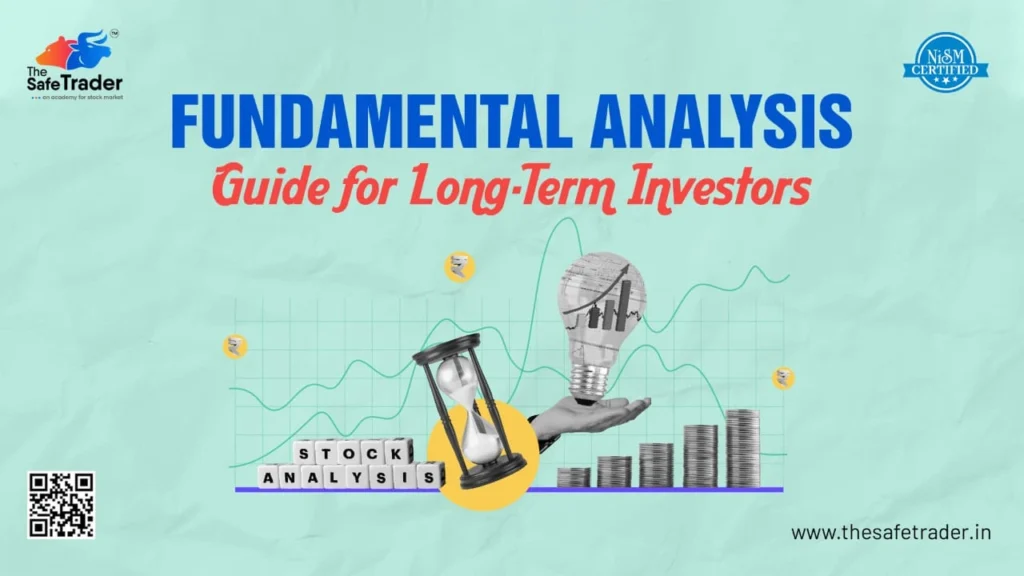
Fundamental Analysis Guide One of the most important skills that any long-term investor should possess is fundamental analysis. If the question, “What is fundamental analysis?” has ever crossed your mind, or looked for a systematic method to assessing firms prior to making an investment, this guide will be useful. As the most reputable stock market training center in India, The Safe Trader gives aspiring traders and investors like you the skills, information, and guidance they require to successfully navigate the markets and succeed over a long period of time. What is Fundamental Analysis? Fundamental analysis is the process of determining a company’s actual worth by looking at its financial information, performance, position in the market, and prospects for expansion. This method explores more into the business itself than short-term trading, which is primarily focused on price charts. You can determine whether a company is overvalued or undervalued by learning the fundamentals of stock analysis. This empowers you to make profitable, well-informed, and astute investment choices. Even if you’re new to investing, we at The Safe Trader teach you how to use this strategy successfully. Why Fundamental Analysis Matters for Long-Term Investors Investing can be challenging for beginners. However, by using fundamental analysis, you can: We at The Safe Trader think that providing you with useful information is important. In order to ensure that you acquire both theoretical knowledge and practical skills, our live mentorship programs concentrate on demonstrating how to apply this analysis in actual markets. Types of Fundamental Analysis Every investor should be aware of the two primary forms of fundamental analysis: You can get a comprehensive picture of the business you’re analyzing by combining these two types. We at The Safe Trader assist you in comprehending both so that you can approach investing with confidence and clarity. Components of Fundamental Analysis For beginners, the process is made simpler by breakdown the elements of fundamental analysis. Among the crucial elements are: In order to help you make better investment decisions, we at The Safe Trader offer practical training that teaches you how to use these elements. How to Fundamentally Analyse a Stock Every long-term investor needs to develop the ability to analyze stocks fundamentally. This is a simplified procedure: You will receive step-by-step instruction on how to implement this process under mentorship at The Safe Trader. Our courses guarantee that you will be able to understand ratios and use them to make wise investment choices, not just memorize them. Why Learn Fundamental Analysis with The Safe Trader? The Safe Trader has empowered aspiring traders both in India and globally. Our training is based on the following and is led by Mr. Mallinath Mulage, an experienced mentor with over 5+ years experience & 5 NISM certifications, specializing in Forex, Futures, and Options trading. The Safe Trader is currently India’s leading stock market training institution. We are committed to helping beginners achieve their trading objectives, with a focus on: Start Your Fundamental Analysis Journey Today Fundamental analysis of stocks is the foundation if you want to confidently accumulate wealth. Take control of your investments by learning how to assess businesses, find undiscovered possibilities, and safeguard your financial future. Visit The Safe Trader Academy now. Enroll in our expert-led programs now. Take the first step toward long-term investing success by learning how to analyze stocks fundamentally.
Simple Tips to Start Trading with Low Investment Online
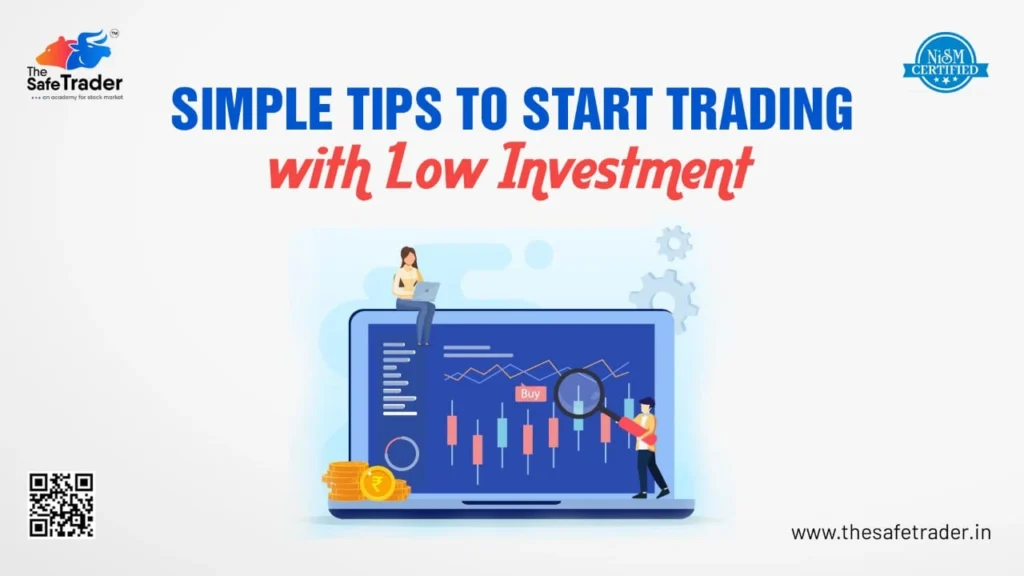
Simple Tips to Start Trading with Low Investment If you’re new to the stock market and searching for tips to start trading, you don’t need a large amount of capital to begin. You don’t need a lot of money to start trading if you’re new to the stock market and looking for advice. Actually, a lot of wealthy traders began slowly and expanded gradually. You can begin trading with little capital and still get significant results if you have the correct strategies, information, and direction. Our specialty at The Safe Trader, the most reputable stock market training center in India, is assisting beginners in making their first confident steps into the trading world, regardless of their level of investment. Why Start Trading with Low Investment? A lot of beginners are nervous because they believe trading requires significant financial resources. The fact is, however, that it makes sense to start with modest funds. With the right tips to start trading stocks, you can: At The Safe Trader, we guide you with practical, easy-to-follow lessons so that even a small investment becomes a valuable learning experience. Simple Tips to Start Trading with Low Investment Here are some simple tips to start trading with low investment that beginners can apply right away: Top Tips to Start Trading with Low Investment When it comes to trading smartly, here are some top tips to start trading with low investment that can help maximize your growth: At The Safe Trader, we make sure beginners not only survive but also achieve success in the market by teaching them these kinds of techniques in our training courses. Best Tips to Start Trading with Low Investment The techniques you apply are more important for trading success than the size of your capital. Here are some of the best tips to start trading with low investment that we share with our students: You will gain a boost right away by learning tried-and-true trading techniques that are effective even with modest sums under the guidance of The Safe Trader’s knowledgeable mentors. Begin Your Trading Journey Today Starting small means being wise, cautious, and laying a solid foundation-it doesn’t mean limiting your potential. You can reduce risks and gradually increase your portfolio if you start trading with the correct advice. Visit The Safe Trader Academy now. Today and take a look at our courses for beginners & advanced learners. Discover easy ways to begin trading with little capital and develop the self-assurance to trade more effectively even with limited funds.
Options Trading: A Beginner’s Guide to Smart Strategies
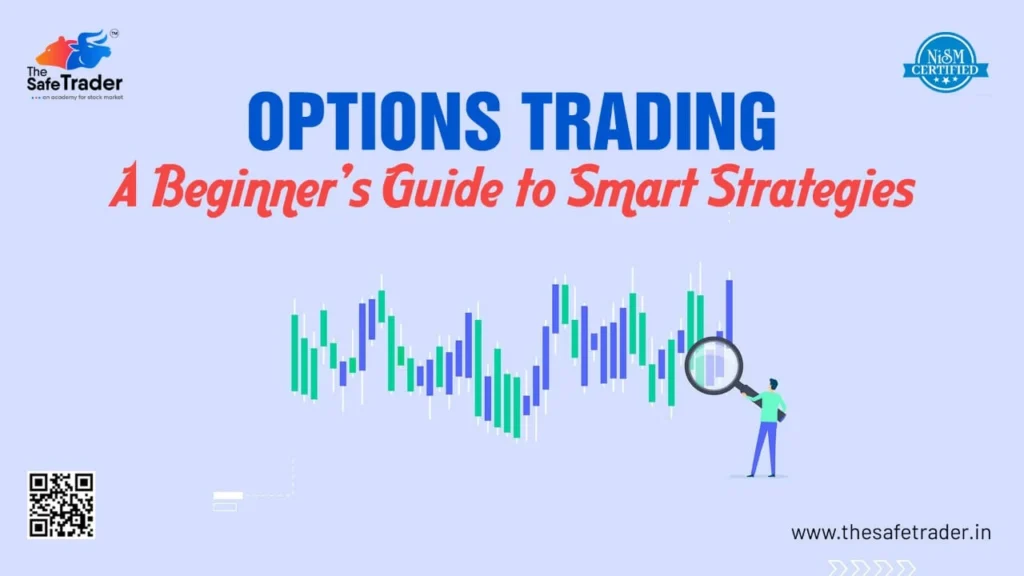
Options Trading for Beginners One of the most effective ways to trade stocks and increase your earning potential is through options trading. This document will help you learn the fundamentals, examine the various kinds, and find trading strategies if you’ve ever wondered, “What is options trading?” or searched for a beginners’ guide to options trading. Thousands of aspiring traders just like you have benefited from our instruction, practice, and confident success at The Safe Trader, India’s most reputable stock market training center. What is Options Trading? Buying and selling contracts that grant you the right, but not the responsibility, to purchase or sell an underlying asset at a predetermined price within a predetermined time frame is known as options trading. Options give you the ability to trade based on future price movements with little risk and a high potential for leverage, in contrast to stocks, where you own the shares. This may seem complicated to novices. For this reason, The Safe Trader’s options trading beginner’s guide aims to make things easy to understand, provide solid groundwork, and equip you with useful skills that you can use in actual markets. Why Options Trading is Perfect for Beginners Beginners can benefit from flexibility and opportunities in options trading that are not available in traditional stock investing. Among the advantages are: In addition to teaching you the fundamentals of options, we at The Safe Trader additionally show how to use them with skilled techniques that fit your objectives and way of life. Options Trading Types You Should Know Before beginning, it’s important for beginners to understand the primary categories of options trading types: Depending on your trading style and risk tolerance, our mentors at The Safe Trader assist you in selecting the best type, each of which has advantages and disadvantages. Options Trading Strategies for Beginners Never trade without a plan if you want to be successful. Learning options trading strategies is therefore essential. Among the most successful techniques we instruct are: At The Safe Trader, we make these strategies easy to understand and apply by providing real-time examples, charts, and practical practice. Why Learn Options Trading with The Safe Trader? Aspiring traders in India and around the world have been empowered by The Safe Trader. Our training is based on the following and is led by Mr. Mallinath Mulage, an experienced mentor with over 5+ years experience & 5 NISM certifications, specializing in Forex, Futures, and Options trading. The Safe Trader is now the top stock market training center in India. We’re dedicated to assisting beginners in realizing their trading goals, with an emphasis on: Empowering Education: Get knowledge from professionals who have practical experience.Skilled Mentoring: Personalized advice to fit your trading preferences.Practical Learning: Not just textbook theory, but real-world applications.Verified Outcomes: Over 5,000+ students worldwide have already started their trading journey with us.Transparent Approach: Just practical skills, no empty promises. The Safe Trader’s Options Trading Beginners Guide Our options trading beginners guide offers the kind of organized direction that every beginner requires. Our programs are customized to your level of experience, from learning the fundamentals of call and put options to becoming proficient in more complex strategies. You won’t ever feel lost on your journey thanks to live sessions, one-on-one mentoring, and a helpful trading community. Rather, you will gain the ability to trade with clarity and confidence. Start Your Options Trading Journey Today This is your opportunity if you’re serious about learning how to trade options and establishing a solid stock market foundation. Learn how to make money from the markets instead of just keeping an eye on them. We’ll give you the information, abilities, and attitude you need to be successful at The Safe Trader Visit The Safe Trader Academy now. To begin your successful journey, enroll in one of our expert-led options trading courses today.
Swing Trading: A Beginner’s Guide to Profitable Moves
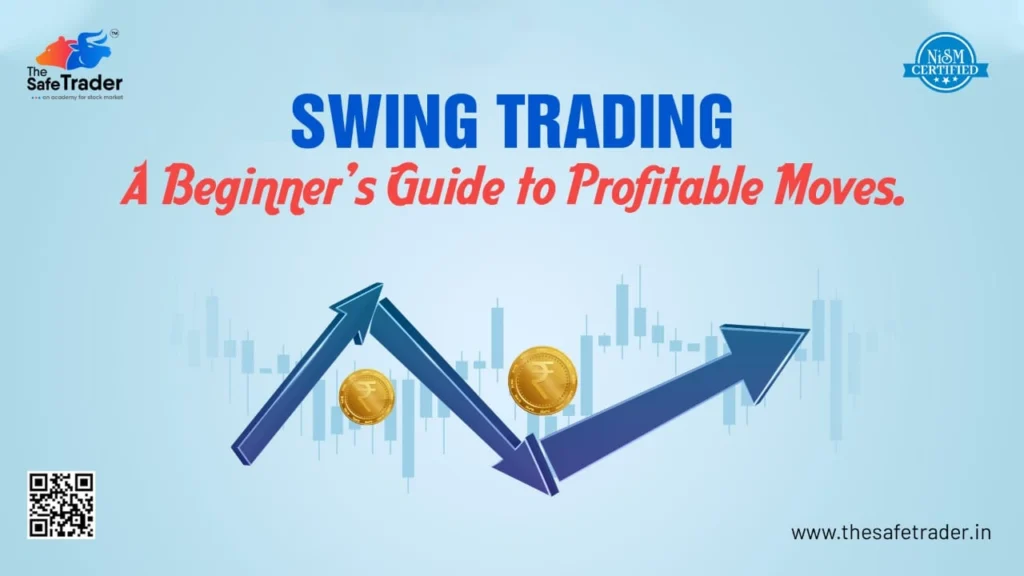
Swing Trading for Beginners For traders who want to capitalize from short- to medium-term price movements without spending their days stuck to a screen, swing trading is one of the most flexible and promising techniques for trading. This guide will help you confidently begin swing trading if you’re wondering what it is or what the best swing trading strategy is. At The Safe Trader, India’s most trusted stock market training institute, we simplify trading concepts and provide you with the tools, mentorship, and proven methods to turn trading into a successful journey. What is Swing Trading? Fundamentally, swing trading is the practice of holding stocks, currencies, or commodities for a few days to weeks in order to capitalize from market “swings.” By combining technical and fundamental analysis, swing traders capitalize on larger price movements as opposed to day traders, who close positions every day. Because it balances long-term investing with fast-paced trading, this approach is perfect for beginners. All you need is the appropriate swing trading techniques and the self-control to stick to them; you don’t have to spend your days in front of a screen. At The Safe Trader, we guide you through the market step-by-step so you can employ strategies that are proven to be effective with confidence. Why Choose Swing Trading as a Beginner? If you’re new to trading, swing trading for beginners offers many advantages: At The Safe Trader, our programs are made to help you navigate all of these advantages so you can make more informed decisions without feeling overpowered. Swing Trading Strategies You Can Start With Without tried-and-true strategies, a trading plan cannot be considered complete. At The Safe Trader, we teach the following swing trading techniques: In addition to teaching you these techniques, our mentorship focuses on modifying them to meet your specific goals, risk tolerance, and market preferences. Swing Trading Indicators You Must Know Your trading journey is guided by indicators. The following are some of the best swing trading indicators: In addition to teaching you how to read these indicators, we at The Safe Trader also show you how to combine them with price action to create the most effective swing trading strategy. Why Learn Swing Trading with The Safe Trader? Aspiring traders in India and around the world have been empowered by The Safe Trader. Our training is based on the following and is led by Mr. Mallinath Mulage, an experienced mentor with over 5+ years experience & 5 NISM certifications, specializing in Forex, Futures, and Options trading. The Safe Trader is now the top stock market training center in India. We’re dedicated to assisting beginners in realizing their trading goals, with an emphasis on: The Best Swing Trading Strategy for You At The Safe Trader, we assist you in finding the best swing trading strategy that suits your trading objectives and personality, even though there isn’t a single “perfect” strategy that works for everyone. Our mentoring makes sure you understand when to enter, how to control risk, and when to confidently exit the market, whether you’re trend-following, breakout trading, or buying and selling. Because trading is about developing discipline and a mindset that supports achievement over time, rather than just techniques, this individualized approach is what sets us apart. Take the First Step Toward Smart Swing Trading Now is the perfect moment to start learning swing trading for beginners. Don’t allow doubts or confusion to stop you. With the correct direction, resources, and coaching, you can begin trading consistently and confidently. Visit The Safe Trader Academy today to explore our comprehensive training programs. Start building your skills, apply proven swing trading strategies, and become part of a supportive trading community that’s committed to your success.
Gold Price Hits ₹1.08 Lakh: What’s Next?
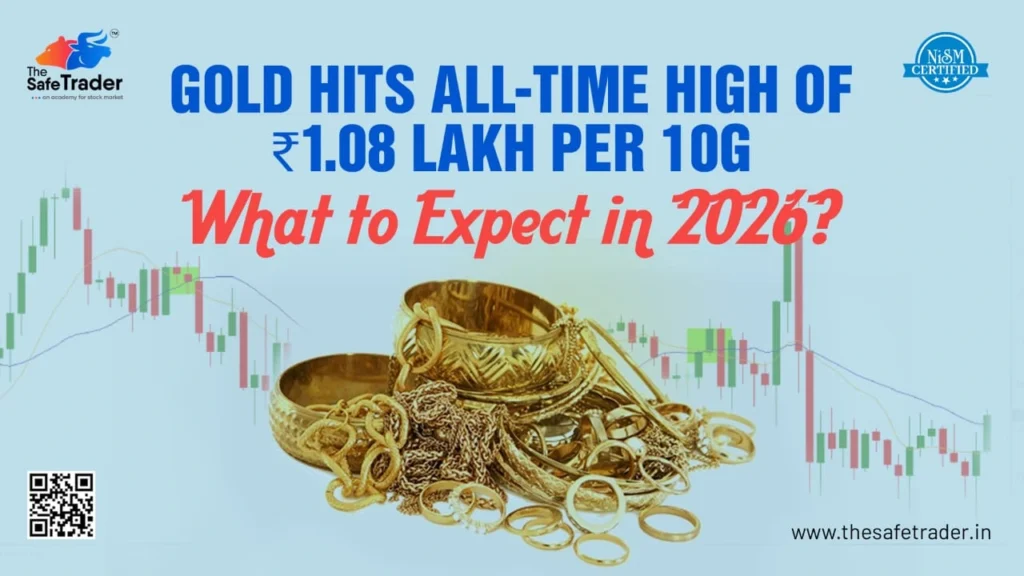
Gold Price Hits All-Time High Due to both domestic market sentiment and powerful international signals, the gold price in India has risen to an all-time high of ₹1.08 lakh per 10 grams. Given that local demand is still strong and global gold prices are close to all-time highs, investors and industry observers are wondering where the price of gold is likely to go in 2026. Why the Gold Price Is Rising Rapidly A range of significant economic and international trends are driving the current gold price rally: US Fed Rate Cut Expectations: Interest rate cuts are more likely now that the US economy is growing more slowly and job data is weaker. Lower rates frequently devalue the US dollar, increasing the appeal of gold on a worldwide scale. Dollar Weakness: The US Dollar Index has depreciated, which has contributed to an increase in the price of gold both globally and in rupees. Secure Demand: Because gold is stable and safe, investors are still drawn to it as concerns about inflation and global unrest appear. Central Bank Purchasing: The RBI in India and other central banks have been increasing their gold reserves steadily, which has helped to keep prices stable. Gold Price in September 2025: Latest Updates The most recent prices and market levels are as follows: If U.S. interest rate cuts are confirmed in the upcoming quarter, analysts anticipate that the price of gold will soon test ₹1.09 lakh. What Will Drive the Gold Price in 2026? The following are the primary factors that might affect the direction of the gold price in 2026: Driver Impact on Gold Price US Federal Reserve Policy Lower interest rates tend to boost gold demand Global Inflation Trends Persistent inflation increases the appeal of gold Currency Exchange Rates Weak rupee increases local gold price Geopolitical Uncertainty Political and economic instability favors safe-haven assets Central Bank Gold Buying Sustains long-term price support Gold Price vs Other Investment Options The price of gold has produced strong and reliable returns when compared to more conventional investment categories: Gold is still a reliable security, particularly in uncertain economic and unstable times. Domestic Trends Shaping the Gold Price in India Local circumstances also have a significant impact on the price of gold in India: What to Watch in the Gold Price Going Forward Key indicators to monitor over the next 6-12 months: Final Thoughts A significant milestone supported by reliable data and market sentiment is reached when the price of gold hits ₹1.08 lakh per 10 grams. Gold’s outlook is still bullish as 2026 draws near, bolstered by inflation worries, rate expectations, dollar weakness, and geopolitical uncertainty. To stay ahead in the changing gold market, keep aware of monetary policy developments, global price movements, and MCX gold rates.For the latest market updates and insights, follow The Safe Trader Academy. Disclaimer:The information provided here is purely for educational and informational purposes only and reflects our personal analysis and opinions. We are not SEBI-registered advisors. Please consult a qualified financial advisor before making any investment decisions.
Day Trading for Beginners: A Complete Guide
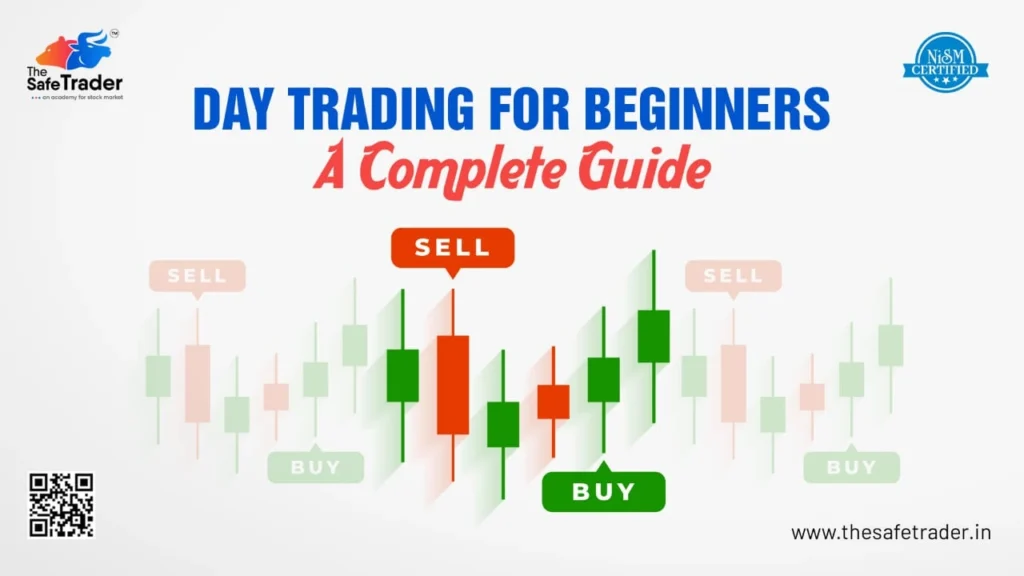
Day Trading for Beginners One of the most exciting and possibly rewarding ways to trade stocks is through day trading. This guide is for you if you’ve ever wondered, “What is day trading?” or whether you want to know how to begin creating an enjoyable trading career. As the most reputable stock market institute in India, The Safe Trader provides aspiring traders like you with the knowledge, self-assurance, and methods necessary to turn day trading into an enjoyable side career or a reliable source of income stream. What is Day Trading? Buying and selling financial instruments within the same day in order to profit from transient market movements is known as day trading. Day traders concentrate on minor price changes and make several trades during the day, in contrast to long-term investors. This may seem difficult to newcomers, but day trading can lead to financial independence with the correct instruction and direction. We at The Safe Trader have assisted thousands of students in comprehending the fundamentals of trading and turning them into useful abilities. Our structured programs make day trading easy, understandable, and successful, regardless of your level of market experience. Why Choose Day Trading for Beginners If you’re considering trading as a side job or a career, day trading provides: Fast Results: Gains or losses are realized every day; there is no need to wait months or years for returns. Reduced Overnight Risks: To prevent overnight market surprises, day traders close all positions before the market closes. Flexibility: Trading is perfect for people looking for independence because, with the right training, you can do it from anywhere. Scalability: You can raise trade sizes and possibly boost outcomes over time once you become proficient in day trading techniques. At The Safe Trader, we prioritize developing practical skills through live mentoring, tried-and-true methods, and useful market insights rather than merely teaching theory. Types of Day Trading Prior to beginning your journey, it is essential that you understand the types of day trading: Under the leadership of Mr. Mallinath Mulage, who has more than five NISM certifications and more than 5+ years of experience in Forex, Futures, and Options trading, our team of mentors is committed to providing individualized advice. We’ll assist you in determining the trading approach that best suits your financial objectives, time constraints, and personality. Mastering Day Trading Strategies Since they enter the market without a plan, many newcomers struggle. We teach tried-and-true day trading techniques at The Safe Trader that center on: Market Analysis: Understanding technical charts, indicators, and price action. Risk management: Long-term success depends on safeguarding your money. Trading Psychology: Developing discipline and emotional control. Entry and Exit Points: To reduce risks, know when to buy or sell. Why The Safe Trader is Your Best Choice The Safe Trader is now the top stock market training center in India. We’re dedicated to assisting beginners in realizing their trading goals, with an emphasis on: We’re more than a training academy-we’re your partner in creating financial independence. Start Your Day Trading Journey Today This is an opportunity to take action if you’ve been looking for simple, approachable advice on day trading for beginners. The Safe Trader offers everything you require, including training, mentorship, and a helpful community, whether your goal is to become a full-time trader or generate additional revenue. Visit The Safe Trader today to explore our courses and start mastering day trading strategies. Don’t let fear or confusion hold you back. With the right guidance, your success in day trading is only a decision away.
Kaushalya Stock Analysis: How It Gained 120% in 12 Days

This Kaushalya stock analysis will help you see the value of momentum and technical patterns if you’re new to the stock market and want to learn how to identify opportunities early. A lesser-known stock, Kaushalya Infrastructure Development Corporation Ltd., recently produced a 120% return in just 12 trading days. This is a prime illustration of how volume analysis, breakout tactics, and patience can pay off effectively. Examining this Kaushalya stock chart can assist you in making better investment choices, regardless of your level of experience. Kaushalya Stock Analysis: Price Chart Overview As can be seen in the above image, Kaushalya stock spent several months in a tight wedge pattern. While most investors ignored it, it quietly traded around ₹650 from late 2024 to mid-2025, consolidating. A significant breakout took place on August 19, 2025. Kaushalya jumped 122.74% in just 12 days, reaching an intraday high of ₹1,841.90. Strong institutional participation was confirmed by the trading volume, which surged to 23,240 shares. This was a classic breakout trade for traders, with a slow buildup and a sharp price acceleration. About Kaushalya Infrastructure Development Corporation In 1992, the construction and infrastructure firm Kaushalya Infrastructure was founded in Kolkata. The business works in a number of industries: The company is listed on the NSE and BSE and has ISO 9001:2008 certification. Kaushalya is in a good position to profit from India’s fast urbanization and economic expansion thanks to rising government spending on infrastructure. Why This Breakout Matters for Traders The breakout of the Kaushalya stock was not random; rather, it followed to a standard pattern. What you can learn is as follows: 1. Before Explosion, Formation Kaushalya provided the ideal foundation for a powerful rally by trading in a small range for months. 2. Using Volume as a Confirmation Process The sharp increase in volume indicated that smart money was buying the stock. 3. Work of Technical Patterns Traders who were quick to recognize the wedge breakout pattern were rewarded when it played out beautifully. 4. Your partner is momentum. Fast-moving stocks frequently maintain their trend, providing a variety of trading opportunities. Personalized Guidance for Aspiring Traders Imagine learning these methods under the guidance of a professional mentor in real time if this analysis captures your interest. At The Safe Trader Academy, we help you: Like Kaushalya, our students have developed their trading confidence by successfully identifying early setups. Why Kaushalya Stock Is a Must-Watch Companies like Kaushalya Infrastructure are in the news because of how well India’s infrastructure industry is doing. The current rally demonstrates that when technical and fundamental indicators line up, small-cap stocks can produce enormous gains. There will always be another opportunity, even if you were unable to make this trade. The secret is to equip yourself with the appropriate information and resources. Final Thoughts – Apply Knowledge to Action The Kaushalya stock analysis teaches the value of technical analysis and goes beyond a simple price chart review. You can become the trader who sees the next big winner by developing your ability to read patterns, volume, and momentum. Your Next Action: Join The Safe Trader Academy to acquire the abilities to: Don’t just watch the market-learn it, trade it, and grow with it. Disclaimer:The information provided here is purely for educational and informational purposes only and reflects our personal analysis and opinions. We are not SEBI-registered advisors. Please consult a qualified financial advisor before making any investment decisions.
Trump’s 50% Tariff Shock: How Will It Impact the Indian Stock Market?
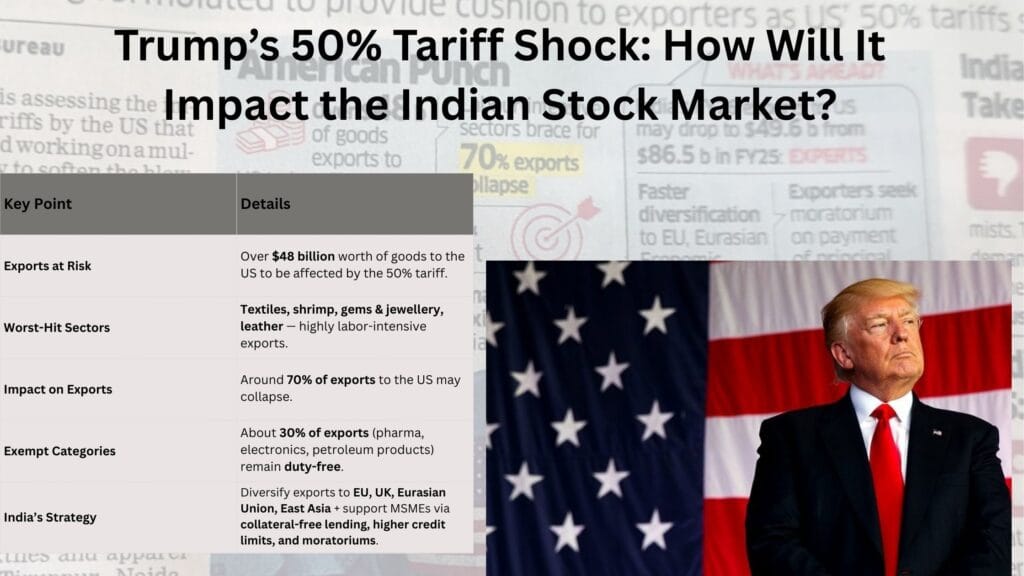
President Trump’s 50% tariff on Indian exports has sent shockwaves across global trade. With over $48B at risk, India’s textiles, gems, and shrimp industries face the hardest blow. Here’s a deep dive into the impact on exports, stock markets, and India’s strategy to counter this challenge. When American President Donald Trump declared a 50% tariff on Indian products, it created ripples across the world markets and policy circles. For India, whose exports to America amount to approximately $86.5 billion every year, this is not only an economic shock but also a strategic setback. With labor-intensive industries such as textiles, gems, jewelry, shrimp, and leather in the firing line, the impact is anticipated to cascade into India’s economy, equity markets, and jobs. However, amidst the crisis is a chance for India to reform, diversify, and come out on top. Why This 50% Tariff Matters The U.S. continues to be India’s biggest export market, taking nearly 17% of India’s total exports. By using a punitive tariff of 50%—double the previous 25%—the U.S. has essentially doubled the price of Indian goods for American consumers. This makes Indian exports considerably less competitive compared with those from China, Vietnam, Bangladesh, and other Asian rivals. More than $48 billion of Indian exports will be adversely affected, as per government estimates. Experts caution that in certain industries, shipments could be up to 70% wiped out, resulting in devastating revenue and employment losses. Industries in the Line of Fire Key Point Details Exports at Risk Over $48 billion worth of goods to the US to be affected by the 50% tariff. Worst-Hit Sectors Textiles, shrimp, gems & jewellery, leather — highly labor-intensive exports. Impact on Exports Around 70% of exports to the US may collapse. Exempt Categories About 30% of exports (pharma, electronics, petroleum products) remain duty-free. India’s Strategy Diversify exports to EU, UK, Eurasian Union, East Asia + support MSMEs via collateral-free lending, higher credit limits, and moratoriums. The lion’s share of the tariff shock will hit labour-intensive sectors: Textiles & Apparel: India’s garment hubs in Tiruppur, Ludhiana, and Noida risk losing orders to cheaper competitors in Vietnam and Bangladesh. Gems & Jewelry: Surat’s diamond polishing industry and Mumbai’s jewelry exporters face the threat of order cancellations, with American buyers likely shifting to alternatives. Shrimp & Seafood: India is one of the largest suppliers of shrimp to the U.S., but tariffs could cripple coastal economies dependent on aquaculture exports. Leather & Carpets: Such niche but high-employment sectors are likely to face drastic reductions in U.S. demand. Conversely, approximately 30% of India’s exports are duty-free, which consists of medicines, electronics, petroleum products, and APIs (active pharmaceutical ingredients). Although that brings some respite, these sectors are not as employment-intensive as textiles or gems, rendering the job market extremely vulnerable. Macro Impact on India’s Economy The tariff increase is not merely a trade matter—it has broader macroeconomic consequences: Losses in Exports: India may face losses of $25 billion to $55 billion in exports per year. GDP Growth Slump: Economists put the loss in GDP growth at 30–80 basis points, which could bring India’s growth down to near 6% if action is not taken. Currency Pressure: A broadening trade deficit can cause the rupee to weaken, increasing the price of imports like crude oil and electronics. Employment Shock: With millions of employees in textiles and gems, job cuts can soar if exporters don’t pass on the tariff cost. Stock Market Reaction The Indian stock market, a reflection of investors’ global sentiments, will likely see increased volatility: Losers: Midcap textile, gem, seafood, and chemical export-oriented companies could experience immediate selling pressure as bottomlines get trimmed. Winners: Home-based FMCG, infrastructure, and retail companies might benefit as supply turns inward. Exporters diversifying to Europe, ASEAN, and the Middle East can also be looked at as solid plays. Foreign Investors: FIIs (Foreign Institutional Investors) might become cautious, resulting in short-term outflows. For investors, the approach must be in defensive sectors, policy-driven stories (such as infrastructure), and diversely exposed global companies. India’s Response: From Damage Control to Reform The government has already started thinking about a multi-pronged approach to soften the blow: Faster Diversification: Increasing exports to EU, UK, Gulf, East Asia, and African markets to break overreliance on the U.S. MSME Support: Collateral-free loans, increased credit limits, and subsidies to assist small exporters in weathering the crisis. Loan Moratoriums: Expanding moratoriums on interest payments of export-linked loans up to a year. Trade Diplomacy: Meeting with allies to negotiate new bilateral trade agreements and mitigate market risks. Former NITI Aayog CEO and G20 Sherpa Amitabh Kant has termed the tariff incident a “wake-up call” for India. He feels that rather than be cowed down, India should take advantage of this opportunity to drive through audacious, once-in-a-generation reforms, consolidate MSMEs, and raise its global competitiveness. Conclusion: A Punch That Could Build Strength The Trump tariff shock is certainly painful—particularly for India’s labor-intensive export sectors. But it also reveals a persistent weakness: India’s over-reliance on a very narrow slice of export markets. If policymakers and business leaders take bold action, this crisis moment can be the turning point for India’s economic and trade transformation. By diversifying export, speeding up reforms, and reinforcing domestic industries, India can convert this reverse into a chance—becoming stronger, self-reliant, and more globally competitive in the years to come.
Trading vs Investing: Key Differences Beginners Often Miss
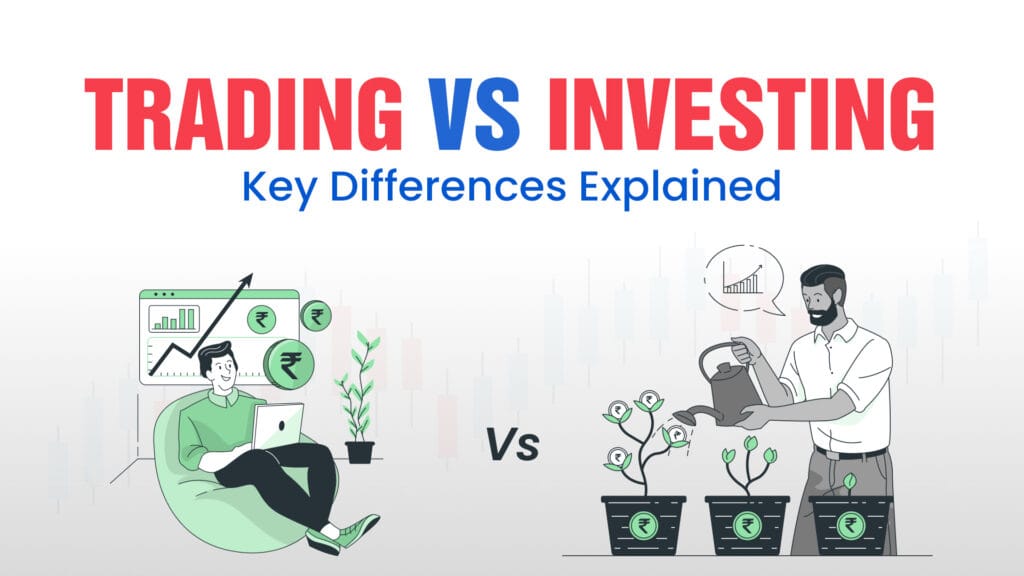
Trading vs Investing Explained When we talk about generating income in the stock market, two popular methods are in vogue: trading and investing. On the surface, they might appear to be the same thing-after all, both involve the purchase and sale of stocks or other investments. Yet the tactics, objectives, and timelines are quite different. Knowing the difference between trading and investing is paramount if you wish to select the appropriate method for your financial journey. This article deconstructs the main differences between stock investing and stock trading, so you can make an informed decision as to which one fits your goals, lifestyle, and risk tolerance better. What is Investing? Investing refers to the act of purchasing assets like stocks, bonds, mutual funds, or ETFs with a long-term holding strategy. Investors typically concentrate on accumulating wealth over time, based on the power of compounding, dividends, and business growth. The strategy is not to pursue quick gains but to allow money to work for you in the long term. Investors consider a company’s fundamentals-business model, financials, market opportunity, and management-prior to investing in shares. ✅ Timeframe: Years or decades✅ Goal: Creating wealth in the long term✅ Strategy: Buy-and-hold, diversification, fundamental analysis✅ Example: Investing in shares of Infosys or Reliance and holding them for 10+ years Trading is generally riskier than investing, particularly if diversified across sectors and asset classes. But it demands discipline and patience to ride out short-term market vagaries. What is Trading? Trading, in contrast, involves profiting from temporary market movements. Traders continuously purchase and sell stocks, commodities, currencies, or derivatives over days, weeks, or even minutes. In contrast to company fundamentals, traders use technical analysis, trends, and charts of prices to their advantage. Trading is intended to make profits quickly based on minor price movements. This, however, involves greater risk, as prices may shift erratically. ✅ Duration: Seconds, hours, days, or months✅ Objective: Quick gains✅ Technique: Technical analysis, market timing, active trading✅ Example: Purchasing NIFTY options in the morning and selling the same day for profit Trading can be profitable, but it requires time, attention, and experience. Without risk management and discipline, traders may incur huge losses. Key Differences Between Trading and Investing Here’s a quick comparison to clearly understand the trading vs investing difference: Factor Trading Investing Time Horizon Short-term (minutes to months) Long-term (years to decades) Objective Quick profits Steady wealth creation Risk High, due to volatility Moderate to low (with diversification) Analysis Used Technical charts & price action Fundamental analysis & company value Approach Active participation Passive wealth-building Returns Can be quick but inconsistent Slow but more consistent over time Both trading and investing involve risks, but the nature of the risks are different: Trading Risks: Market volatility can cause deep losses. Emotional decision-making tends to get the trader out too soon or in too long. Needs strict stop-loss rules. Investment Risks: Market downturns will temporarily impact portfolio value. Returns are slower, thus patience is needed. Needs keeping up with company performance. Knowing these risks will assist you in choosing which method better suits your financial personality. Which is Better: Trading or Investing? It depends on your objectives, risk tolerance, and lifestyle: If you want long-term stability, less stress, and slow accumulation of wealth, then investing is a better option. If you like chart analysis, fast decision-making, and can manage risk, then trading is for you. Most successful people actually do both methods-investing a part of their capital in the long term while employing another portion for short-term trade. Final Thoughts Comparing investing vs trading, it’s evident that both have their own strengths and weaknesses. Trading is able to make fast money but takes time, expertise, and risk. Investing, as a contrast, is about stability and long-term wealth generation through patience and compounding. Ultimately, it all comes down to your goals, personality, and how much time you are willing to spend on the markets. Interested in learning more? Check out our in-depth guide on Stock Trading vs Investingto make wiser investment choices. Visit The Safe Trader Academy today to explore our comprehensive training programs. Start building your skills, apply proven swing trading strategies, and become part of a supportive trading community that’s committed to your success.
Losing Your IT Job? Discover the Most Powerful Skill to Start Earning Fast

Losing Your IT Job? Here Are the Top Skills to Learn Fast and Start Getting Paid IT layoffs are a bitter truth now. Week after week, we hear announcements of big companies cutting jobs—either because of automation, international slowdowns, or want of cost-cutting. For many professionals, it means sleepless nights, financial woes, and wondering about the future. But here is the truth: losing your job does not mean losing your means of earning. In fact, it may be the chance you’ve been waiting for to learn a lifetime skill—a skill that doesn’t rely on bosses, companies, or global markets. That skill is trading. Why Trading Is the Best Skill to Learn Now Unlike coding, software tools, or certifications that are subject to becoming obsolete, trading is an ever-perpetuating business. The markets—stock, forex, or crypto—will always be there, and they will always offer opportunities. Here’s how trading is a career skill despite layoffs: ✅ Short Learning Curve – You don’t require years. With good mentorship, you can begin trading in 60 days.✅ Low Initial Investment – You can begin with an investment of just ₹10,000.✅ Work From Home – No need for an office, a commute, or a boss—just your computer or phone.✅ Lifetime Skill – Once you acquire the skill of trading, no recession or layoff can deprive you of it.✅ Unlimited Opportunities – The more people coming into the market, the more growth and opportunities there are for you. But Wait—Don’t Jump In Blindly Trading can transform your life, or it can empty your pockets if done blindly. One wrong move could cost you a fortune. That’s why you have to learn to trade properly before you even invest. At Safe Trader Academy, we have witnessed hundreds of professionals, including IT employees who were laid off, achieve a change in their lives through the study of technical analysis, intraday techniques, and risk management. We don’t only show you how to make money; we show you how to safeguard your capital. What Sets Safe Trader Academy Apart? Your Next Step After a Layoff If you’ve lost your IT job or are at the risk of losing it, don’t spend time brooding. Instead, invest in yourself. Trading is not an alternative—it can become your prime source of revenue and a lifelong skill. Keep in mind—jobs may go away, but skills are with you for life. And trading is one ability that can enable you to come back stronger after a layoff.
